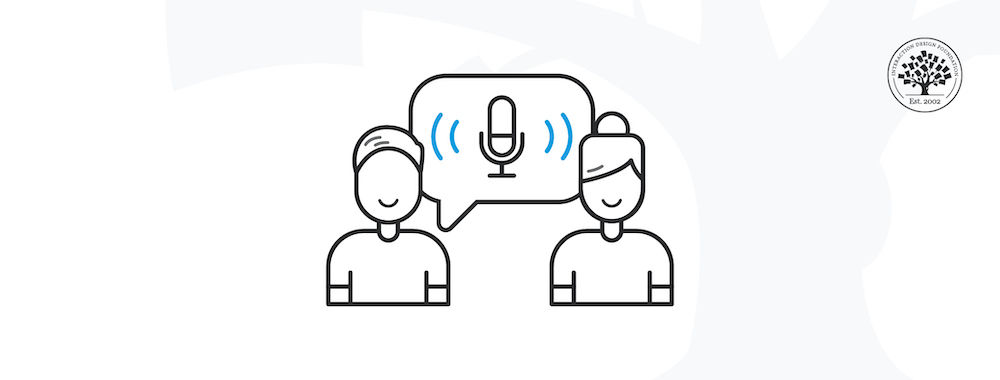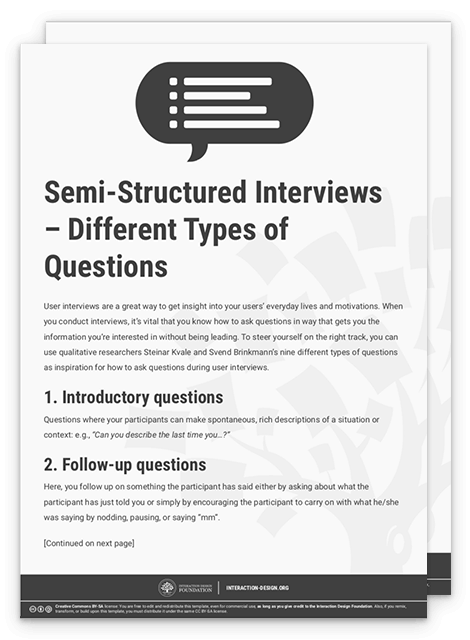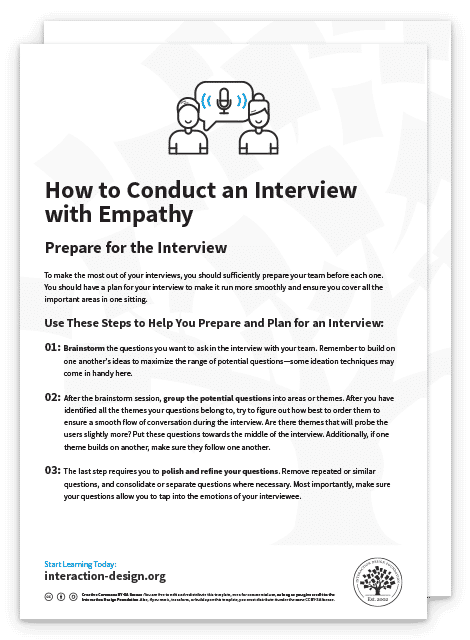Pros and Cons of Conducting User Interviews

- 775 shares
- 5 years ago
Semi-structured interviews are a research method that uses both predetermined questions and open-ended exploration to gain more in-depth insights into participants' perspectives, attitudes, and experiences.
Explore how semi-structured interviews can yield essential insights to guide better designs, in this video with Ann Blandford, Professor of Human–Computer Interaction at UCL.
Semi-structured interviews are commonly used in social science research, market research, and other fields where an understanding of people's attitudes, behaviors, and beliefs is important.
Semi-structured interviews have several key characteristics that differentiate them from other types of interviews:
The flexible nature allows researchers to dive deeper into a topic and adapt the interview based on new insights or issues. Unlike structured interviews, which rely on a fixed set of questions and responses, semi-structured interviews allow for more open-ended discussion, which can lead to unexpected insights and perspectives.
Their emphasis is on participant perspectives and experiences. Rather than simply gathering participant data or information, the purpose of semi-structured interviews is to understand how participants think and feel about particular topics or issues. This approach allows researchers to understand better the social and cultural contexts in which participants live and work.
They are often used in research projects that aim to generate new ideas or theories rather than test existing ones. Because they allow for open-ended discussion and exploration, they can effectively generate new insights into complex social phenomena.
Semi-structured interviews use a combination of predetermined questions and open-ended exploration to learn more about participants' perspectives. There are three main categories of questions you can use:
Open-ended Questions: These are broad, general questions that allow participants to express their thoughts and feelings on a topic without restriction. Open-ended questions typically begin with phrases like "Tell me about..." or "How do you feel about...". These questions help encourage participants to share their experiences and perspectives in their own words.
Closed-ended Questions: Closed-ended questions are more specific and provide the participant with predetermined responses. These questions typically begin with phrases like "Do you agree or disagree with..." or "Which option best describes...". Closed-ended questions can help gather data on specific attitudes or behaviors.
Probing Questions: Probing questions are follow-up questions that aim to clarify or expand upon a participant's response. These questions typically begin with phrases like "Can you tell me more about..." or "Why do you think that is...". Probing questions can help a researcher to understand a participant's thought process or experience.


Proper preparation is key to conducting successful semi-structured interviews. Below are some tips for preparing for your interviews:
Define Your Research Questions: Before conducting interviews, it's important to understand your research questions and objectives clearly. This will help you develop a set of initial questions to guide your interview process.
Develop an Interview Guide: An interview guide is a list of questions and prompts designed to elicit information from participants. It should include open-ended and closed-ended questions and probing questions to encourage participants to elaborate on their responses.
Pilot Test Your Interview Guide: It's important to pilot test your interview guide with a small group of participants before conducting full-scale interviews. This will allow you to identify potential issues or areas where the questions must be revised.
Identify and Recruit Participants: Ensure that your sample is representative of the population you are studying. Consider using targeted sampling methods, such as snowball sampling or maximum variation sampling, to recruit participants who can provide diverse perspectives.
Schedule Interviews: Once you've identified and recruited participants, it's time to schedule interviews. Be sure to allow adequate time between interviews for transcription and analysis.
Conduct Interviews: During the interview process, it's important to establish rapport with participants and create a comfortable environment where they feel safe sharing their experiences and opinions. Be sure to follow your interview guide while allowing flexibility in response to unexpected information during the discussion.
Provide Compensation or Incentives to Participants: Consider offering compensation or incentives to participants to encourage their participation. Compensation can come in many forms, such as gift cards, cash, or vouchers. It can also be non-monetary, such as offering participants the opportunity to receive a summary of the study's findings or the chance to participate in future research projects. Compensation or incentives can help to show participants that their time and contributions are valued and appreciated.
Plan your research with this helpful checklist. Then, get ready to conduct semi-structured interviews! Download this template for help in creating different types of interview questions.


Take our course on User Research – Methods and Best Practices.
Read more about the process of conducting semi-structured interviews.
Learn how to analyze the data from your semi-structured interviews.
Read this reflection on semi-structured interviews as a research instrument.
Learn how to use the snowball sampling method to recruit participants.
Do you need more diversity in your study? Try maximum variation sampling.
User researchers prefer semi-structured interviews because they balance consistency with flexibility. Unlike structured interviews, which follow a strict script, semi-structured formats allow researchers to guide the conversation while adapting to each participant’s responses. Non-structured interviews might flow too freely and allow users to drift into tangents. Meanwhile, a semi-structured approach uncovers deeper insights into user behaviors, motivations, and pain points.
Semi-structured interviews use open-ended questions to prompt rich storytelling. Researchers can then probe further according to what users reveal. This flexibility leads to discoveries that rigid approaches often miss. For example, when exploring how users interact with a health app, a semi-structured format might uncover emotional drivers behind tracking habits—not just usability issues. Researchers value this approach because it can surface context-specific, qualitative data that shapes user-centered designs.
Explore qualitative research to understand the rich variety of techniques that can yield rich insights from users.
Use a semi-structured interview during the discovery and early design phases. This is when you need to explore user needs, behaviors, and motivations in depth—especially when you don’t yet know what to ask precisely. Semi-structured interviews help you uncover insights that inform personas, user journeys, and product direction.
They work best when you want to balance consistency (asking all participants similar questions) with adaptability (probing unexpected responses). For example, if you’re designing a budgeting app, a semi-structured interview can reveal how users emotionally relate to money, not just how they track expenses.
Take a deep dive into Personas with our course Personas and User Research: Design Products and Services People Need and Want.
Begin by defining your research goal. What do you want to learn—user behaviors, motivations, pain points? Next, create a guide with open-ended questions grouped by topic. These serve as anchors to ensure consistency while allowing flexibility.
Design your questions to encourage storytelling. You ideally want to set the scene by asking participants to think back to the last time they did the things you are interested in finding out about. For example, instead of asking “Do you use a budgeting app?” ask, “Can you walk me through how you manage your finances day-to-day?” Include follow-up prompts like “Why?” or “What happened next?” to dig deeper. Also, the setting for the interview should support this wherever possible.
Choose participants who reflect your target users and schedule 30–60-minute sessions. Test your guide with a dry run so you can see where to refine questions and flow. Record sessions only with the consent of the users.
Get a greater grasp of the Pros and Cons of Conducting User Interviews in our article about it.
To write effective open-ended questions for a semi-structured interview, focus on prompts that encourage users to share stories, not just answers. Start with phrases such as “Can you describe…”, “Tell me about…”, or “What was it like when…”. These invite reflection and reveal context.
Don’t use “yes/no” or leading questions—so, instead of “Do you like this feature?”, ask: “How do you use this feature in your daily routine?” Effective questions dig into motivations, emotions, and experiences. Group them around themes—like habits, challenges, or expectations—and use follow-ups like “Why was that important to you?” or “What happened next?” to go deeper.
Write neutrally, don’t use jargon, and test questions in a pilot interview to refine tone and clarity.
Discover important insights about how to write effective questions for user interviews.
To encourage users to talk openly and honestly in a UX interview, create a safe, respectful environment from the start. Start with some small talk to build rapport and then explain the purpose of the interview and assure users there are no right or wrong answers. Make clear that their feedback will shape better design—not judge them.
Use a calm, neutral tone and active listening techniques (nods, affirmations, and reflective questions) to show genuine interest. Don’t interrupt or react with surprise, especially to negative comments—even quiet sighs or “wow” expressions from you can skew results. Let silence work; users often reveal deeper insights after a pause.
Frame questions to invite stories, not opinions, and be patient. Trust grows when users feel heard, respected, and free from judgment.
Explore valuable aspects of how to approach interview situations in this video with Ann Blandford: Professor of Human-Computer Interaction at University College London.
Stay curious when users give unexpected or off-topic answers during a semi-structured interview. These detours often expose hidden needs or assumptions that scripted questions may miss. Listen fully and assess whether this new direction offers user experience insight.
If so, explore it with follow-up questions like “Can you tell me more about that?” If not, gently steer the conversation back. Use a soft transition like, “That’s really interesting. I’d love to come back to it later, but can we return to how you use the app in the morning?”
Keep your tone respectful and flexible. The best interviews feel like conversations, not interrogations, and some of the richest insights come from the unexpected.
Gain important insights into how rapport helps shape effective interviews, in this video with Ann Blandford, Professor of Human-Computer Interaction at UCL.
If you’ve recorded the interviews (with participants’ consent), begin by transcribing the conversations. This can be done automatically through various specialist services or AI. Then, read the transcripts to identify patterns, themes, and recurring user behaviors or emotions. Use affinity mapping or thematic coding to group similar insights—for example, frustrations with onboarding, motivations behind daily use, or unmet needs.
Tag quotes with labels like “goal,” “pain point,” or “workaround” to organize your findings. Prioritize insights based on frequency, emotional intensity, or relevance to your design goals. Look for contradictions or surprises—they often lead to the most valuable innovations.
Summarize the key themes in user journey maps, personas, or problem statements to inform your next design steps.
Learn How to Do a Thematic Analysis of User Interviews in our article.
Use triangulation; cross-check insights with data from other sources. Combine interview themes with observations, surveys, analytics, or usability tests. You've gained stronger evidence if multiple methods point to the same user need or pain point.
Look for consistency across participants. If several users express similar concerns or behaviors, the insight likely reflects a broader trend. For example, if many users say they avoid a feature because it confuses them, that’s a clear signal to act.
Share findings with teammates or stakeholders for feedback, as they may spot gaps or offer new perspectives. Validation helps transform raw insights into reliable design decisions.
Try triangulation to understand its tremendous potential in design. In this video, with William Hudson, User Experience Strategist and Founder of Syntagm Ltd.
To adapt semi-structured interviews for different user types or cultures, tailor your language, tone, and questions with sensitivity. Local researchers are particularly valuable here, as they could either help with the interviews or review some of the questions and topics to be discussed. It’s particularly important where the primary researcher isn’t a native speaker of the participant’s language.
It’s important to use culturally appropriate phrasing; what feels conversational in one culture may seem intrusive or overly casual in another. Avoid jargon or assumptions about technology use, routines, or values.
When interviewing across cultures, start with extra rapport-building and explain the purpose clearly. Adjust examples to match users’ experiences—what works for a tech-savvy urban user may confuse someone in a rural setting. Some cultures value storytelling, while others prefer directness, so observe cues and match the user’s communication style.
Consider translation needs and local norms around privacy or hierarchy, too. Culturally adapted interviews yield more honest, relevant insights.
Climb aboard cultural considerations for design endeavors, in this video with Alan Dix: Author of the bestselling book “Human-Computer Interaction” and Director of the Computational Foundry at Swansea University.
Copyright holder: Tommi Vainikainen _ Appearance time: 2:56 - 3:03 Copyright license and terms: Public domain, via Wikimedia Commons
Copyright holder: Maik Meid _ Appearance time: 2:56 - 3:03 Copyright license and terms: CC BY 2.0, via Wikimedia Commons _ Link: https://commons.wikimedia.org/wiki/File:Norge_93.jpg
Copyright holder: Paju _ Appearance time: 2:56 - 3:03 Copyright license and terms: CC BY-SA 3.0, via Wikimedia Commons _ Link: https://commons.wikimedia.org/wiki/File:Kaivokselan_kaivokset_kyltti.jpg
Copyright holder: Tiia Monto _ Appearance time: 2:56 - 3:03 Copyright license and terms: CC BY-SA 3.0, via Wikimedia Commons _ Link: https://commons.wikimedia.org/wiki/File:Turku_-_harbour_sign.jpg
Interview 5 to 10 users to gather reliable insights in semi-structured interviews, as this range often uncovers 80%–90% of core themes and pain points. The exact number depends on your user base’s diversity—more variation (for example, in age, roles, or cultures) may require more interviews to surface patterns across segments.
Focus on depth over volume. Semi-structured interviews produce rich, qualitative data, so fewer well-conducted sessions can reveal more than dozens of shallow ones. After 5 interviews, review your notes: Are you noticing recurring themes? If not, continue until patterns emerge.
Balance insight quality with research scope. Your goal isn’t statistical certainty, but enough consistency to design confidently and exceed the reasonable expectations you’ve learnt more about.
Harvest some additional helpful points in our article How to Moderate User Interviews.
Satter, S. (n.d.). Semi Structured Interview: What, When, and How to Use in UX. Trymata Blog. Retrieved July 17, 2025, from https://trymata.com/blog/semi-structured-interview/
This practical guide clearly outlines semi‑structured interviews as a balanced method combining prepared questions with conversational flexibility—a format especially useful in UX research and usability testing. It walks through creating interview guides, obtaining consent, asking follow‑up queries, thematic coding, and triangulating findings. The post highlights benefits—such as richer user insights, contextual depth, and adaptability—and drawbacks like potential bias and analysis time. UX designers will find the step‑by‑step examples (e.g., “tell me why this felt confusing?”) and clear procedures particularly useful for structuring effective interviews and translating qualitative feedback into actionable design insights.
Dovetail Editorial Team. (2023, February 5). Semi‑Structured Interview: Explanation, Examples, & How‑To Guides. Dovetail Blog. Retrieved July 17, 2025, from https://dovetail.com/research/semi-structured-interview/
This article defines semi‑structured interviews as a flexible yet organized research method—mixing planned open‑ended questions and on‑the‑fly follow-ups. It covers question design, recommended 30–60‑minute length, use of verbal and nonverbal cues, and analysis techniques like thematic sorting. The post clearly contrasts this approach with structured and unstructured interviews, emphasizing its strengths in depth, rapport-building, and contextual insight valuable for iterative UX work. With concrete guidance and real-use examples, it supports UX designers in implementing robust interview plans that uncover user motivations and attitudes throughout product discovery, testing, and ongoing research workflows.
Galletta, A., & Cross, W. E. (2013). Mastering the Semi-Structured Interview and Beyond: From Research Design to Analysis and Publication. NYU Press.
This book is a comprehensive guide to conducting semi-structured interviews, particularly valuable for researchers in social sciences and design fields like UX. Galletta and Cross integrate theoretical grounding with practical tools for designing, executing, and analyzing interviews. The authors emphasize reflexivity and adaptability, key aspects of effective qualitative research, and provide a longitudinal case study to illustrate application. This work is influential for teaching interview methodology, supporting novice and experienced researchers. Its structured yet flexible approach helps UX practitioners balance exploration and consistency when gathering user insights, making it a staple in both academic and professional qualitative research toolkits.
Remember, the more you learn about design, the more you make yourself valuable.
Improve your UX / UI Design skills and grow your career! Join IxDF now!
You earned your gift with a perfect score! Let us send it to you.
We've emailed your gift to name@email.com.
Improve your UX / UI Design skills and grow your career! Join IxDF now!
Here's the entire UX literature on Semi-Structured Interviews by the Interaction Design Foundation, collated in one place:
Take a deep dive into Semi-Structured Interviews with our course User Research – Methods and Best Practices .
Master complex skills effortlessly with proven best practices and toolkits directly from the world's top design experts. Meet your experts for this course:
Frank Spillers: Service Designer and Founder and CEO of Experience Dynamics.
Ann Blandford: Professor of Human-Computer Interaction at University College London.
Alan Dix: Author of the bestselling book “Human-Computer Interaction” and Director of the Computational Foundry at Swansea University.



We believe in Open Access and the democratization of knowledge. Unfortunately, world-class educational materials such as this page are normally hidden behind paywalls or in expensive textbooks.
If you want this to change, , link to us, or join us to help us democratize design knowledge!
